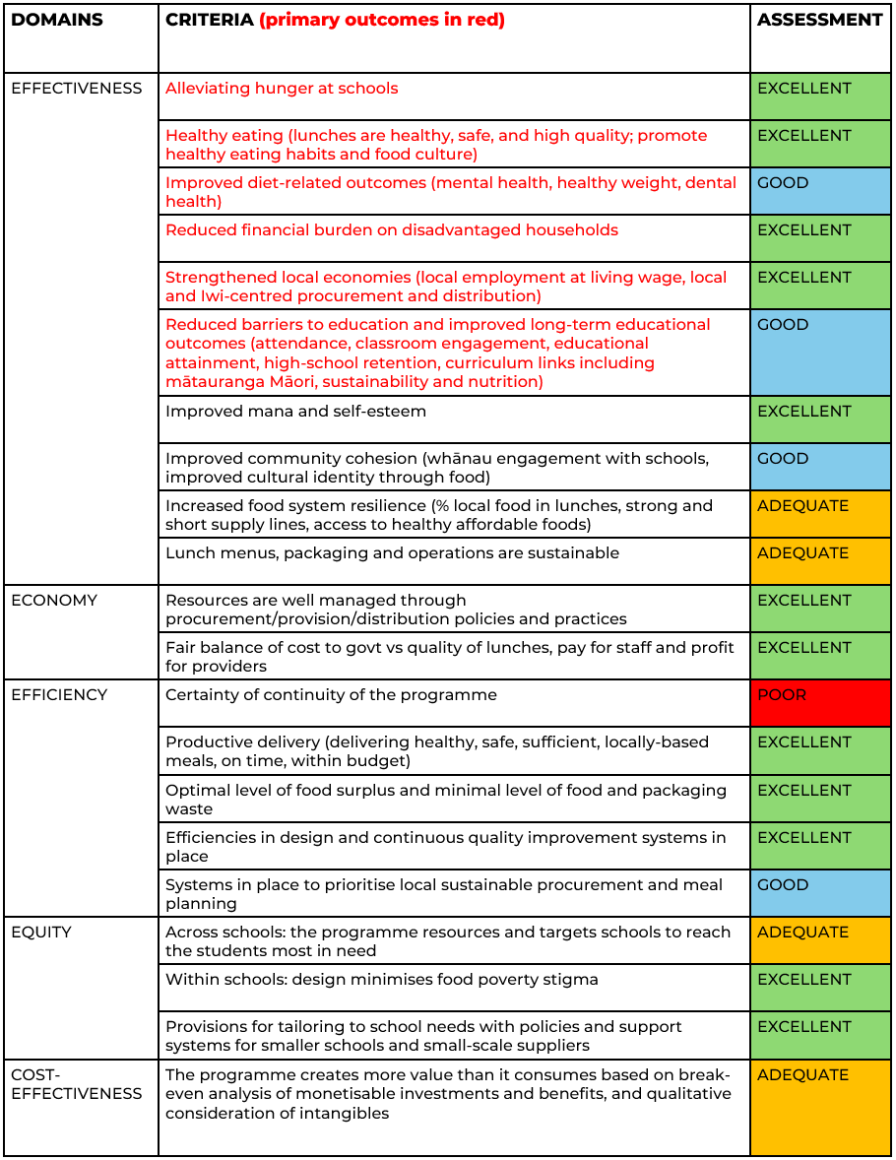References
- Julian King & Associates. Value for Investment. Available at: https://www.julianking.co.nz/vfi/#:~:text=The%20award%2Dwinning%20Value%20for,more%20value%20can%20be%20created. (Accessed 20 March 2024)
- Ministry of Education. Social Wellbeing Committee. Cabinet paper - Implementing a Free and Healthy School Lunch Prototype for Year 1-8 Students. 26 June 2019. Available at https://assets.education.govt.nz/public/Uploads/R-151-153-Redacted2.pdf (Accessed 20 March 2024)
- Ministry of Education. Cabinet Paper: Continuing the Ka Ora, Ka Ako | Healthy School Lunches Programme. 22 March 2021. Available at: https://www.education.govt.nz/assets/Documents/our-work/information-releases/Advice-Seen-by-our-Ministers/March-2021/Cabinet-Paper-material_Redacted.pdf (Accessed 20 March 2024)
- Ministry of Education. Ka Ora Ka Ako | Healthy School Lunches: interim report. Available at: https://www.education.govt.nz/news/ka-ora-ka-ako-healthy-school-lunches-interim-evaluation-report-released/ (Accessed 20 March 2024)
- De Seymour, Jamie, Alessandro Stollenwerk Cavallaro, Laurie Wharemate-Keung, Sheryl Ching, and Jasmin Jackson. Nutrient-Level Evaluation of Meals Provided on the Government-Funded School Lunch Program in New Zealand. Nutrients. 2022; 14(23): 5087. https://doi.org/10.3390/nu14235087.
- Vermillion Peirce P, Jarvis-Child B, Chu L, Lennox K, Kimber N, Clarke H, et al. Ka Ora, Ka Ako New Zealand Healthy School Lunches Programme Impact Evaluation. Wellington; 2022
- McKelvie-Sebileau P, Swinburn B, Glassey R, Tipene-Leach D, Gerritsen S. Health, wellbeing and nutritional impacts after 2 years of free school meals in New Zealand. Health Promot Int. 2023; 38(4):daad093. doi: 10.1093/heapro/daad093. PMID: 37590384; PMCID: PMC10434982
- Aikman P, Yates-Pahulu R. He Kai Kei Aku Ringa: Evaluation of the Iwi and Hapu Social Procurement and Partnership Model, under Ka Ora, Ka Ako | The Healthy School Lunches Programme. 2023;75. Available at: KOKA He-Kai-Kei-Ringa_Evaluation-Report-FINAL-.pdf (Accessed 21 March 2024)
- Ministry of Education. School Term Surveys for Ka Ora, Ka Ako I Healthy School Lunches Programme School Term Surveys 2021 -2023. Internal Government documentation.
- Standard of Proof. Ka Ora, Ka Ako | New Zealand Healthy School Lunches Programme. Supplementary attendance analysis for most underserved ākonga. 13 March 2024. Available at: https://assets.education.govt.nz/public/Documents/our-work/strategies-and-policies/Ka-Ora-Ka-Ako-attendance-18-03-24.pdf (accessed 20 March 2024)
- McKelvie-Sebileau P, Swinburn B. Food poverty for NZ teens creating an achievement lag of up to four years. 5 March 2024. Available at: https://www.phcc.org.nz/briefing/food-poverty-nz-teens-creating-achievement-lag-four-years (Accessed 19 March 2024)
- McKelvie-Sebileau P, Railton R. Evidence for free school lunches: The impact of hunger on learning. 21 March 2024. https://www.phcc.org.nz/briefing/evidence-free-school-lunches-impact-hunger-learning Available at (Accessed 21 March 2014)
- New Zealand Government. Procurement. Designated Contract Areas. Available at: https://www.procurement.govt.nz/broader-outcomes/designated-contract-areas/ (Accessed 18 March 2024)
- Ministry of Education Ka Ora, Ka Ako Healthy School Lunches. 2023 Updates for Suppliers. 9 Feb 2024. Available at: https://kaorakaako.education.govt.nz/working-together/programme-updates/2023-update-for-suppliers#december-2023 (Accessed 18 March 2024)
- Reported through Ka Ora Ka Ako’s internal complaint system (personal communication, Ministry of Education)
- Ministry of Education. Panel Agreement Ka Ora, Ka Ako Heathy School Lunches Programme. 2023. Available at: https://assets.kaorakaako.education.govt.nz/s3fs-public/zYE1HMpokqWU3ZeDrEhsF6z2zQmehW3OZUtopRyz.pdf (Accessed 18 March 2024)
- Gonçalves, C.; Saraiva, S.; Nunes, F.; Saraiva, C. FoodWaste in Public Food Service Sector—Surplus and Leftovers. Resources 2023; 12(120). https://doi.org/10.3390/resources12100120
- Analysis of New Zealand PISA (Program for International Student Assessment) database (personal communication, Ministry of Education)
About the Briefing
Public health expert commentary and analysis on the challenges facing Aotearoa New Zealand and evidence-based solutions.
Subscribe

Public Health Expert Briefing
Get the latest insights from the public health research community delivered straight to your inbox for free. Subscribe to stay up to date with the latest research, analysis and commentary from the Public Health Expert Briefing.
